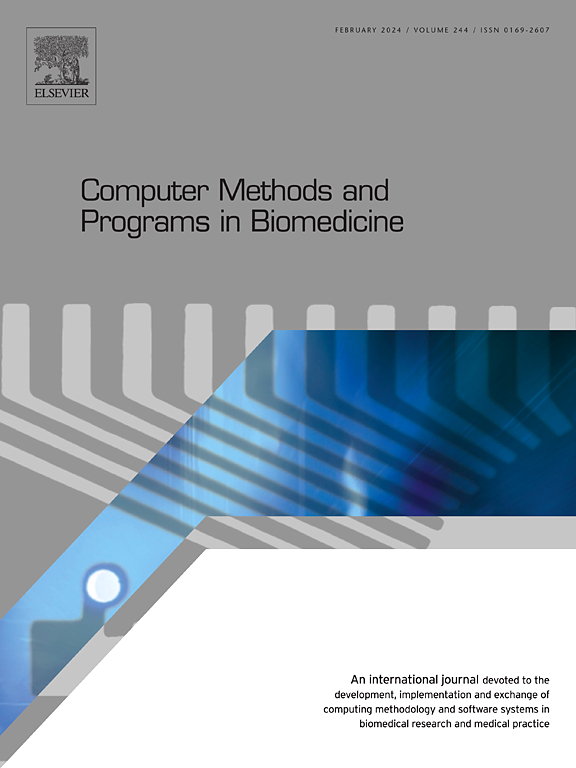Relationship Between the Elastic Modulus of the Novel Pedicle Screw-Plate System and Biomechanical Properties Under Osteoporotic Condition: A Power-Law Regression Analysis Based on Parametric Finite Element Simulations
IF 4.9
2区 医学
Q1 COMPUTER SCIENCE, INTERDISCIPLINARY APPLICATIONS
引用次数: 0
Abstract
Background and objective
The novel pedicle screw-plate system (NPSPS) is a new internal fixation method for the thoracic spine that we proposed, which has demonstrated effectiveness through clinical practice and biomechanical testing. Nevertheless, the optimal elastic modulus of NPSPS (NPSPS-E) remains debated, particularly for osteoporosis patients. We propose a more efficient method to predict the biomechanical effects of NPSPS across varying elastic moduli in osteoporosis using parametric finite element (FE) analysis, establishing the regression relationship between NPSPS-E and biomechanical properties.
Methods
An FE surgical model of NPSPS under osteoporotic conditions was developed. The NPSPS-E was linearly varied from 3.6 GPa (polyether ether ketone) to 110 GPa (titanium alloy). Using power-law regression analysis, a functional equation was established to correlate NPSPS-E with biomechanical properties under osteoporotic condition.
Results
Power-law equations and regression models were successfully established between NPSPS-E and biomechanical prediction indices under osteoporotic condition (P<0.0001). As NPSPS-E increased, the range of motion (ROM) of the T8-T10 spinal segments decreased from 0.51°-4.06° to 0.24°-1.45°. The mean von Mises stress in the T8-T10 vertebrae declined from 1.36 MPa-2.03 MPa to 1.15 MPa-1.79 MPa. Concurrently, the stress shielding ratios and the total stress ratios of the NPSPS increased from 3.66%-48.07% and 13.96%-26.96% to 10.70%-56.20% and 52.62%-64.40%, respectively.
Conclusion
The functional equations derived from these models serve as a predictive tool to directly estimate the biomechanical effects of NPSPS across a range of elastic modulus under osteoporotic conditions, thereby facilitating the design and optimization of NPSPS materials.
骨质疏松条件下新型椎弓根螺钉-钢板系统弹性模量与生物力学性能的关系:基于参数化有限元模拟的幂律回归分析
背景与目的我们提出的新型椎弓根螺钉-钢板系统(NPSPS)是一种新的胸椎内固定方法,通过临床实践和生物力学试验证明了其有效性。然而,NPSPS的最佳弹性模量(NPSPS- e)仍然存在争议,特别是对骨质疏松症患者。我们提出了一种更有效的方法,通过参数化有限元(FE)分析来预测NPSPS在骨质疏松症中不同弹性模量的生物力学效应,建立NPSPS- e与生物力学性能之间的回归关系。方法建立骨质疏松状态下NPSPS的FE手术模型。npps - e在3.6 GPa(聚醚醚酮)到110 GPa(钛合金)之间呈线性变化。采用幂律回归分析,建立了npps - e与骨质疏松状态下生物力学性能的函数方程。结果骨质疏松状态下npps - e与生物力学预测指标之间建立了幂律方程和回归模型(P<0.0001)。随着NPSPS-E的增加,T8-T10脊柱节段的活动范围(ROM)从0.51°-4.06°下降到0.24°-1.45°。T8-T10椎体的平均von Mises应力从1.36 MPa-2.03 MPa下降到1.15 MPa-1.79 MPa。同时,NPSPS的应力屏蔽比和总应力比分别从3.66% ~ 48.07%和13.96% ~ 26.96%提高到10.70% ~ 56.20%和52.62% ~ 64.40%。结论由这些模型导出的函数方程可作为预测工具,直接估计骨质疏松条件下NPSPS在弹性模量范围内的生物力学效应,为NPSPS材料的设计和优化提供依据。
本文章由计算机程序翻译,如有差异,请以英文原文为准。
求助全文
约1分钟内获得全文
求助全文
来源期刊

Computer methods and programs in biomedicine
工程技术-工程:生物医学
CiteScore
12.30
自引率
6.60%
发文量
601
审稿时长
135 days
期刊介绍:
To encourage the development of formal computing methods, and their application in biomedical research and medical practice, by illustration of fundamental principles in biomedical informatics research; to stimulate basic research into application software design; to report the state of research of biomedical information processing projects; to report new computer methodologies applied in biomedical areas; the eventual distribution of demonstrable software to avoid duplication of effort; to provide a forum for discussion and improvement of existing software; to optimize contact between national organizations and regional user groups by promoting an international exchange of information on formal methods, standards and software in biomedicine.
Computer Methods and Programs in Biomedicine covers computing methodology and software systems derived from computing science for implementation in all aspects of biomedical research and medical practice. It is designed to serve: biochemists; biologists; geneticists; immunologists; neuroscientists; pharmacologists; toxicologists; clinicians; epidemiologists; psychiatrists; psychologists; cardiologists; chemists; (radio)physicists; computer scientists; programmers and systems analysts; biomedical, clinical, electrical and other engineers; teachers of medical informatics and users of educational software.
 求助内容:
求助内容: 应助结果提醒方式:
应助结果提醒方式:


